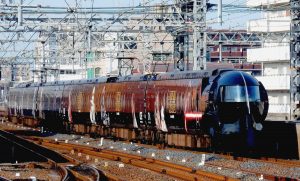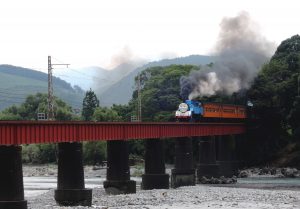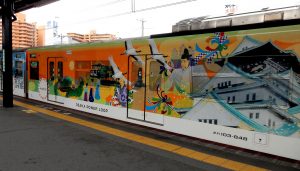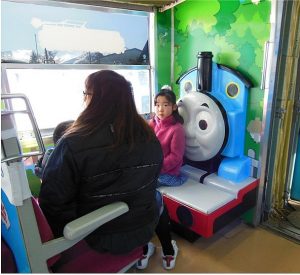Personification of Local trains

Figure 6: “Rapit”-Train of Nankai railway company with temporar advertisement for the new “Star wars” movie. Photo: Wilfried Wunderlich
Why are the passengers attracted by newly wrapped trains? The uniqueness is certainly one aspect, and as wrapping a present makes it look more desirable, wrapping trains attract more passengers. But in the case of Japanese customers there is another reason. When analyzing which type of wrapping trains are popular, we find that figures from fairy-tales, and even more often fictional manga characters like Kamen Rider (1971), Anpanman (1973), and Doraemon (1969) are most popular. From their early childhood Japanese people even know the less common figures such as Ninja Hattori-kun (1964), which runs on Himi-line trains, or GeGeGe-no-Kitarō (1960) on Tottori-line trains. They are standing for experience of (super-)realistic scenes of life, which also have some connections to Japanese mythology. Also, the early TV-characters created in Japan such as Atom-Boy from the 1970s, then Kamen Raider and Ultraman and so on, became popular as modern versions of Robin Hood, helping people in trouble. Nearly every Japanese child knows these characters. Even the music is used for announcing the train departure. Railway fans may notice the Atomboy melody at Takanobaba station on the Yamanote line.
The children’s book “Thomas the tank engine” was published already in 1946 in England and became popular in Japan in the 1990s through popular broadcasting. The eyes in the face turn around as if a human is talking. Children strongly resonate on such characters as Thomas, because they are easy to recognize. The Fuji-Q Highland amusement park runs a small part as “Thomas”-land. The connecting heavy rail Fuji-Kyūkō line converted a 5000-series train into a Thomas-train in 2007. The interior such as seats, wall, and sealing is decorated with such motives which came originally from the children book (figure 7). “What you already know, that attracts your mind” is the driving force, why this initiative remains successful after almost ten years. The phenomenon of embodiment in sociology expresses that people need to build up a personal relationship to the things which surround them for sustainable repeating.
The Oigawa railway in Shizuoka prefecture is known as a quasi-heritage railway. In a three-year experiment they painted in 2015 one of the three historic trainsets in the “Thomas” design (figure 8). Even the rolling of the engine’s eyes was realized. Together with the souvenir sell and other side businesses it turned out to be a success. As the trains were booked out weeks ahead, they converted one year later another engine into a red-colored “James” for the peak season in August.

Figure 8: Oigawa railway realized the “Thomas” engine for a three-year experiment. Photo: Wilfried Wunderlich
The drawbacks of “too fancy” overdoing of this commercialization are “Getting bored by it” or “Losing the corporate identity”. Historians also claimed, why such budget was not used in order to preserve historic trains. Social decisions always have to balance between different opinions. Indeed some train companies keep at least one train set untouched.
Local wrapping trains
Technically available for more than two decades, printed vinyl sheets can be easily attached and later removed to the flat surfaces of any transportation vehicle. While advertisement on tram cars started as early as in the 1920s in urban areas, some modern trains are covered with vinyl foils as standard livery. Wrapping trains on local lines became popular in the last five years.
A vehicle wrap describes the marketing practice [12] of completely or partially covering with pictures of local scenes or historical heroes. Wrapping has temporary character, usually not longer than three years in order to keep its uniqueness and specialty. In 2008 the Odakyu company cooperated with a local school. During a school event children painted the layout of a all six wagons of a commuter train, printed it on vinyl. Each time the children saw their train passing by, they recognized them and cheered.
- Rather than boring advertisement for a specific commercial product or company, local warps usually show destination-related motives or characters adding the components of spirituality, history, or aesthetics of this particular region to the train journey (figure 9). There are several social driving forces for such a development.
- Local communities feel the necessity of private-public-partnership (PPP) for keeping a train service running and design their local train as an expression of: “This is our train” or “If we loose the train connection, we will be cut of the world, and nobody will recognize our community.”
- The opening ceremony itself is a big media event, as well as continuous reports about the train and its journey. “This strengths our community”.
- Attracting passengers, especial young families, who recognize a known character from manga, anime, movies or toys on a train: “Let’s ride on it”.
- A personalized train makes it easy for young children to identify it as “my favorite train”.
- “The journey itself is the goal” is the motto for an unforgettable experience and pulls passengers out of their private car back to public transport on local lines.
- Alongside with the outside livery, also the interior, seats, floors and sealing are often decorated and children don’t feel bored during the train journey.
- The displayed characters on the wrappings are also part of a franchising strategy, as they might increase the sale of manga, anime, movies or toys.
- Bringing back childhood memories to the elderly passengers, who visited their home-region after long period of absence because they moved to urban areas for work.

Figure 9: “Art on trains” promotes the local attractions, such as shown here for Osaka castle. Photo: Wilfried Wunderlich
So, it can be considered as a win-win situation for all, the passengers, the train operators, publishers and last-but-not-least the artists and their studios itself. The mobility of society is accelerated by social digitals networks and magazines. Local wraps are one contributing factor to this dynamic. Another such challenge is the willingness of local shop- or restaurant- owners to provide attractive atmosphere, when passengers arrive at the end point of a country side line. The rail company Choshi Dentetsu finally could survive after they started selling “Senbei” rice cookies as souvenirs. These revenues from the side-business were larger than those from ticket sale.
In literature PPP is discussed controversial. The term is used to describe a financial model with very long-term contracts of more than 30 years. The advantage is providing an infrastructure investment positive for the region; on the other hand PPP is vulnerable to unethical behavior of uncooperative companies due to complicated and undefined legal contracts. As in any new assessment, critical success factors (CSF) were evaluated in each of the different models in Europe [13], UK [14], US [15], and East Asia [16, 17]. Different experiences try to avoid such mistakes in recent projects by defining the visions and setting clear regulations. In Japan financing is much more secured [8, 18] and almost all recent PPP projects are considered as successful. Examples are the recovery of Sanriku Railway after the Tsunami disaster [19], the Toyama light rail [20], the idea of Wakayama railway placing a cat as stationmaster [11] or the community buses, which became popular nationwide in Japan.





